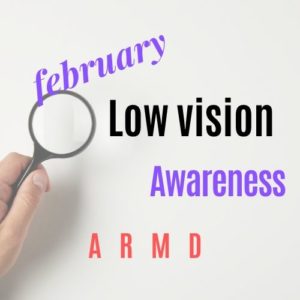Macular Degeneration & Low Vision Awareness


Prevent Blindness, founded in 1908, and dedicated to fighting blindness and saving sight, has declared February to educate the public about ARMD and low vision and bring awareness to the free services the group provides.
What is Macular Degeneration?
ARMD (age related macular degeneration) affects the macula at the back of the retina. The macula is the small central portion of the retina and it has a high concentration of photoreceptor cells that create central vision. The macula is the most sensitive part of the retina giving us 20/20 vision.
The rest of the retina creates peripheral (side) vision. A person with advanced macular degeneration loses the ability to see fine details or read, both close up and at a distance, but does not lose peripheral vision.
There are two types of ARMD—dry and wet. The dry type of degeneration is diagnosed when an eye doctor detects drusen (yellow colored waste deposits) and other characteristic findings within the layers of the retina.
Drusen are NOT Diagnostic of ARMD
But the presence of small drusen in the retina does not always mean that you will develop advanced ARMD. According to the National Eye Institute only 5 percent of people who have drusen in one eye will develop advanced dry ARMD after 10 years, and about 14 percent of people with drusen in both eyes will go on to develop advanced dry macular degeneration.
There is no treatment for advanced dry macular degeneration, but in 2010, after five years of testing, the FDA approved a miniature telescopic implant for advanced macular degeneration. The implanted telescope sends a high-resolution, magnified image, over the macula, the central portion of the retina to restore lost central vision. It takes months of training to reteach the brain to learn to use the implanted device, but results have been promising and with further developments and technical refinements the implantable telescope may become as commonplace and successful as modern cataract surgery.
Wet Macular Degeneration
About 10 percent of ARMD cases are wet macular degeneration. In the wet form, abnormal blood vessels grow in the layer behind the retina. The abnormal blood vessels leak fluid and blood into the layers of the retina. This leaking scars the retina and destroys macular cells, including photoreceptor rods and cones, causing the loss of central vision.
Wet macular degeneration can be treated with anti-VEGF injections. VEGF is an acronym for vascular endothelial growth factor, a protein that causes the abnormal leaky blood vessels.
Anti-VEGF injections have good success rates and have enabled the treatment of what used to be an untreatable condition. The anti-VEGF is injected directly into the white (sclera) of the eye. Patients feel pressure, but little or no pain during the injections.
The injections prevent further growth of abnormal blood vessels and are effective in preventing further central vision loss in 90 percent of treated eyes. In some cases, there is improvement in central vision. In those cases that have improved vision, the average improvement in vision is about 1 to 2 lines on a standard eye chart and about one-third of the patients who experience vision improvement, have vision improvement of 3 or more lines on a standard eye chart.
